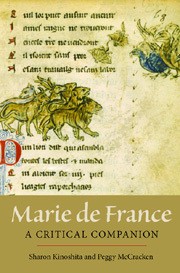Book contents
- Frontmatter
- Contents
- Preface
- Note on Editions
- 1 Introduction: the World of Marie de France
- 2 Communication, Transmission, and Interpretation: Literary History
- 3 Courtly Love and Feudal Society: Historical Context
- 4 Movement and Mobility: Plot
- 5 Bodies and Embodiment: Characters
- 6 Repetition and the Art of Variation: Narrative Techniques
- 7 Posterity: The Afterlives of Marie's Works
- Further Reading
- Index
- Already Published
2 - Communication, Transmission, and Interpretation: Literary History
Published online by Cambridge University Press: 12 September 2012
- Frontmatter
- Contents
- Preface
- Note on Editions
- 1 Introduction: the World of Marie de France
- 2 Communication, Transmission, and Interpretation: Literary History
- 3 Courtly Love and Feudal Society: Historical Context
- 4 Movement and Mobility: Plot
- 5 Bodies and Embodiment: Characters
- 6 Repetition and the Art of Variation: Narrative Techniques
- 7 Posterity: The Afterlives of Marie's Works
- Further Reading
- Index
- Already Published
Summary
“Marie de France” is our name for an author figure who claims to have been born “in France” but composed the texts attributed to her in England, drawing on oral traditions in Celtic and written traditions in Anglo-Saxon and Latin. In contrast to the works of Chretien de Troyes, who describes his sources more allusively – “a book from the library of my lord Saint Peter in Beauvais” (Cligés, l. 21) or “the book of the story of the grail, given him by the count [Philip of Flanders]” (Le conte du graal, ll. 64–5) – Marie's sources have been more precisely identified: directly, in the case of the Espurgatoire saint Patriz, and indirectly, in the case of the Ysope and the Lais. Moreover, Marie persistently calls attention to her own work of linguistic transformation: where Chrétien emphasizes the value-added of his composition – the “mout bele conjuncture” of Erec et Enide (l. 14) or the “painne et…antancion” (l. 29) added to the “[m]atiere et san” (l. 26) supplied by the countess of Champagne in the Chevalier de la charrete – Marie explicitly points to the work of “pulling” narratives over from Celtic, Anglo-Saxon, or Latin, respectively, into written romanz or franceis
- Type
- Chapter
- Information
- Marie de FranceA Critical Companion, pp. 17 - 50Publisher: Boydell & BrewerPrint publication year: 2012



